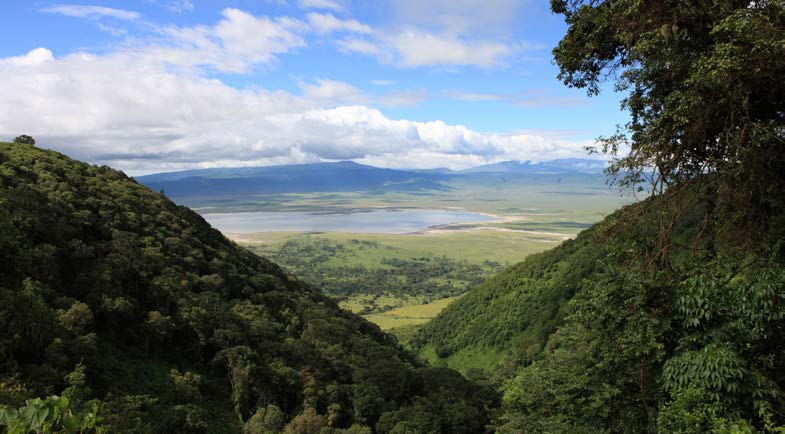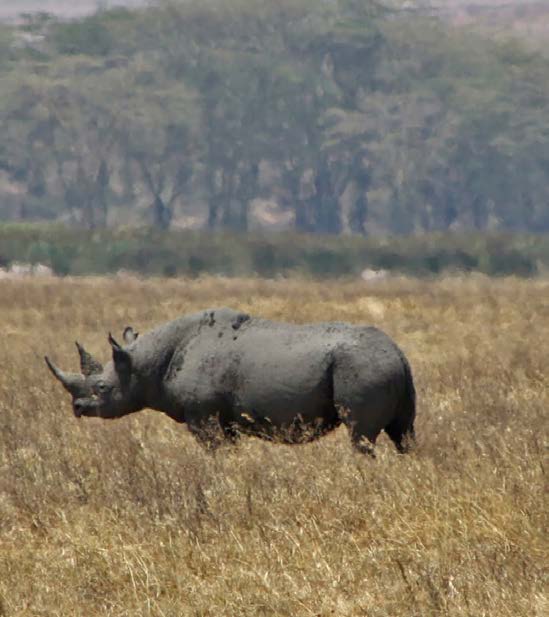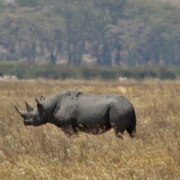Rhino Reflection

by Naples Zoo Director of Conservation Tim L. Tetzlaff
Growing up reading books about Africa printed in the early 1900s, I felt like I held the yellow pages of history itself. But those authors saw only a slice of time. Later I would learn their tales of a Serengeti, unpeopled from time immemorial, were instead skewed observations of a temporary anomaly.
The lack of communities was caused by a disease accidentally unleashed in 1887 that killed 90% of the cattle and untold numbers of antelope across the continent driving a famine that killed an estimated two-thirds of the Maasai people in Tanzania alone. But a limited frame of reference is an easy trap to get caught in.
How many of us once believed diamond engagement rings were a time-honored tradition, instead of the result of a successful 1947 advertising campaign – less ancient than the Slinky, Silly Putty, and Tupperware.

An estimated 25,000 large animals reside within the walls of Ngorongoro Crater.
But getting back to Africa and what has “always been.” Mount Kilimanjaro, the iconic glacier-capped roof of Africa, sets the record as the planet’s tallest free-standing mountain. But geologically, this famous volcano is a relatively recent arrival just 3 million years old. Even our distant ancestors were already leaving bipedal footprints in the fossil record 3.6 million years ago in the shadow of another mountain that nearly equaled Kilimanaro’s height.
But that rival giant volcano vanished from Tanzania’s horizon as it erupted and collapsed in on itself some 2.5 million years ago. What remained was Earth’s largest unbroken, unflooded caldera that we now call Ngorongoro Crater.
Over the eons, the 100-square-mile crater attracted a wealth of wildlife residing within its 2,000-foot-high walls. A ranger in Ngorongoro Crater finds a curious black rhino very close. The telescope will be able to identify individuals from miles away.
It was in our charmed era of Ngorongoro’s history that I first heard of its wonders when my late father, Lawrence “Jungle Larry” Tetzlaff, hosted an East African safari in 1972. Growing up marveling at the abundance of wildlife in his slides and films, what happened over the 20 following years is still hard to fathom.
With relentless poaching fueled by highprices for rhino horn to concoct useless medicines, Tanzania’s 22,000 black rhinos suffered a terrifying free fall – stopped short with just 25 surviving by 1990.

The author’s first black rhino sighting in Ngorongoro
Knowing how rare Tanzania’s rhinos remained, I was profoundly grateful to see one of these three thousand-pound wonders when I hosted the first of many safaris to the Crater myself. But on September 30, 2019, that experience paled to meeting Fausta, believed to be the world’s oldest rhino. She was first documented in the Crater in 1965.
As I watched her, I imagined she could have been one of the rhinos my father saw nearly five decades earlier. That moment became all the more precious when Fausta passed away of natural causes less than two months later at age 57.
As we’ve learned this last year especially, things can change dramatically. A none too subtle reminder to appreciate what we have today. Kilimanjaro has not always towered over the plains, but we live in the age where we can witness the paradox of snow on the equator. Ngorongoro’s majestic heights fell, but somehow it became more magical, and we can journey down into this modern Eden.
Africa’s rhinos nearly went extinct in our lifetime. But as you read this, fierce and tireless efforts launched in the 1990s have exponentially increased the number of black rhinos in Tanzania.
Through the generosity of longtime friend Albert Mollel, I met with the rangers living the reality of those efforts at great personal risk. And that’s not hyperbole. About 1,000 of the world’s park rangers have been killed in the line of duty over the past 10 years. But this wasn’t a social call. As Director of Conservation, I was looking for needs we might be able to meet.
The first answer was easy: tents so rangers could camp in the bush and keep close tabs on the rhinos. And at less than $10,000 that seemed possible. But the second seemed out of reach. The Crater stretches 10 to 12 miles across. To monitor the individual rhinos at distance, rangers need high-powered, tripod-mounted binocular telescopes –the kind used by Coast Guards. They only had a couple but needed many more. The delivered price they were quoted between equipment and import taxes could reach over a quarter million dollars which exceeded their resources – and ours. But with successful negotiations for equipment before, I told them I’d look into it. No promises.
Upon my return to the States and using my prior purchasing manager experience, I eventually sourced a manufacturer who could provide the specifications needed at a greatly reduced price. Arrangements through the Tanzanian government relieved the tax situation.
As most of the Zoo’s core conservation budget is committed to our ten field staff and existing long-term commitments, the majority of funding for these two projects was generously donated by travelers who had been to Ngorongoro Crater on a Naples Zoo safari – at a combined cost of less than $30,000. As of this writing, the tents are already in use and a sample telescope has been successfully field tested.
The rangers eagerly await the full order of telescopes by this summer. I look forward to gazing through one on my next visit – and pausing to reflect that I am blessed to live in a moment when Africa’s rhinos still wander her light-soaked plains. You do, too.
Naples Zoo at Caribbean Gardens is an award-winning, private 501(c)(3) nonprofit serving wildlife and families here and around the world. If you’d like to invest in our conservation efforts or join me in Africa, contact me at tim@napleszoo.org. More information at www.napleszoo.org/conserve.The author’s first black rhino sighting in NgorongoroCrater.




Leave a Reply
Want to join the discussion?Feel free to contribute!